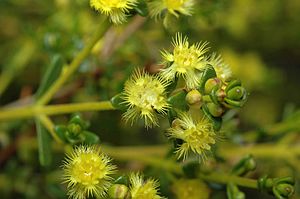Verticordia citrella facts for kids
Quick facts for kids Verticordia citrella |
|
|---|---|
 |
|
| Conservation status | |
| Scientific classification | |
| Genus: |
Verticordia
|
| Species: |
citrella
|
Verticordia citrella is a beautiful flowering plant that belongs to the myrtle family, called Myrtaceae. It's a special plant because it only grows in one place: the south-west part of Western Australia. This means it is endemic to that area.
This plant is a small, bushy shrub. It has lots of branches that grow close together. Its leaves are different depending on where they are on the plant. The leaves on the stems are shaped like cylinders, while those near the flowers are more rounded. Verticordia citrella also has small, bright yellow flowers that grow in groups at the ends of its branches.
Contents
About This Cool Plant
Verticordia citrella is a shrub that grows from a single stem at its base. It has many branches and can reach about 1 meter (3 feet) tall. It can also spread out to about 50 centimeters (20 inches) wide.
The leaves on the main stems are long and thin, like a pencil. They are round when you look at them from the end. These leaves are usually 5 to 10 millimeters (about 0.2 to 0.4 inches) long and get thinner at the tip. The leaves that grow closer to the flowers are different. They are wider and more oval or almost round. These leaves are much smaller, only about 2 to 3 millimeters (about 0.08 to 0.12 inches) long.
The flowers of Verticordia citrella have a light, pleasant smell. They grow in groups that look like a cluster or a flat-topped bunch. Each flower sits on a short stem, about 3 to 5 millimeters (0.12 to 0.2 inches) long.
The floral cup is like the base of the flower. It's shaped like a top, about 1.5 millimeters (0.06 inches) long. It's smooth and a little bumpy. The sepals are like small leaves that protect the flower bud. They are yellow and about 2 millimeters (0.08 inches) long. They have 5 or 6 small parts with fuzzy edges. The petals are the colorful parts of the flower. They are also yellow and about 1.5 to 1.8 millimeters (0.06 to 0.07 inches) long. They have long, finger-like parts that spread out. The style is a thin part in the center of the flower, about 0.8 millimeters (0.03 inches) long. It's straight and smooth. This plant usually blooms from October to November.
There's a plant called V. acerosa that is very similar to Verticordia citrella. However, V. acerosa has bigger leaves and larger flowers. Also, its flowers change color to red or darker shades as they get older.
Naming and Discovery
The plant Verticordia citrella was officially described for the first time in 1991. It was named by a scientist named Alex George. He found the first samples of this plant between the cities of Perth and Toodyay in Western Australia, along with Elizabeth George.
The description of the plant was published in a science journal called Nuytsia. The second part of its scientific name, citrella, comes from a Latin word. Citreus means "lemon-yellow color." The ending -ella makes it sound small. So, citrella refers to the small size and lemon-yellow color of its flowers.
Alex George placed this plant in a specific group within the Verticordia family. He put it in the subgenus Chrysoma and the section Chrysoma. Other plants in this group include V. acerosa, V. subulata, and V. endlicheriana.
Where Does It Grow?
This type of verticordia plant usually grows in sandy soil. This sand often gets wet during the winter months. It likes to grow in open areas where there are many shrubs.
Verticordia citrella is quite rare. It can only be found in one special nature reserve. This reserve is located between the cities of Perth and Toodyay in Western Australia.
Protecting This Plant
The Western Australian Government's Department of Parks and Wildlife keeps track of rare plants. They have given Verticordia citrella a special classification called "Priority Two."
What does "Priority Two" mean? It means that not much is known about this plant. It has only been found in one or a very few places. This classification helps protect the plant and its habitat, so it doesn't disappear.
Growing Verticordia Citrella
People have tried to grow Verticordia citrella in gardens. In Western Australia, it has grown well in soil that drains water easily. It also blooms with many flowers when it gets a lot of sunshine.
It has been harder to grow this plant in eastern Australia. However, some plants have survived for 3 or 4 years when kept in pots. Gardeners can grow new Verticordia citrella plants from small pieces of the parent plant, called cuttings. Sometimes, if the plants are grown in deep sand, new plants can even grow from their own seeds.


